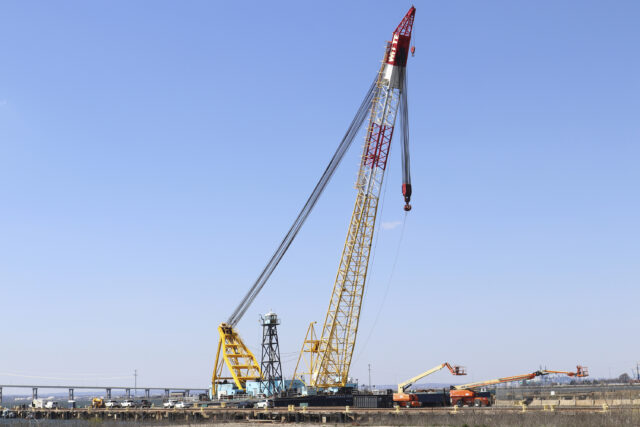A massive 1,000-ton crane, one of the largest on the Eastern Seaboard, has arrived near the site of a collapsed Baltimore bridge as crews prepare to commence the daunting task of clearing the wreckage. The bridge collapse, caused by a collision with a freighter, has halted maritime traffic in and out of the city’s vital Port of Baltimore and impeded the search for four missing construction workers presumed dead.
Maryland Governor Wes Moore has described the situation as an “economic catastrophe,” highlighting the significant challenges involved in recovering the workers and removing the tons of debris to reopen the port, which handles a substantial portion of the nation’s automotive and farm equipment imports.
Moore, who visited the scene, was struck by the extent of the damage, with shipping containers appearing to be torn apart like “paper-mâché.” He revealed that the broken pieces of the bridge weigh up to 4,000 tons, necessitating the cutting of steel trusses to safely lift them from the Patapsco River.
The recovery effort will involve an array of equipment, including seven floating cranes, 10 tug boats, nine barges, eight salvage vessels, and five Coast Guard boats. Moore emphasized the unprecedented nature of the operation, requiring meticulous planning for every step.
Water conditions have prevented divers from entering the river thus far, but efforts to recover the construction workers will resume when conditions improve. The workers, from Mexico, Guatemala, Honduras, and El Salvador, were repairing potholes on the bridge when it collapsed early Tuesday.
The U.S. Coast Guard is focused on removing the remaining bridge debris and the container ship that struck it to clear the port’s shipping lanes. Teams of engineers from various agencies and the private sector are assessing the best methods to dismantle the bridge into manageable pieces for lifting.
Simultaneously, Maryland’s Department of Transportation is already exploring innovative design and construction methods to expedite the building of a new bridge.
Environmental officials have stated that there is no indication of hazardous material releases from the ship or in the water, posing risks to human health. However, authorities have advised the public to stay away from the area and have imposed flight restrictions to facilitate the recovery efforts.
The incident has not only impacted the lives of the workers and their families but also threatens to disrupt the flow of goods through the Port of Baltimore, potentially affecting consumers nationwide. Union leaders are working to support the dockworkers whose jobs are at risk due to the port’s closure.
As the recovery and salvage operation continues, the focus remains on bringing closure to the families of the missing workers and restoring the vital maritime transportation link that the Port of Baltimore provides.
(With inputs from AP)
Also See:
In a career spanning three decades and counting, Ramananda (Ram to his friends) has been the foreign editor of The Telegraph, Outlook Magazine and the New Indian Express. He helped set up rediff.com’s editorial operations in San Jose and New York, helmed sify.com, and was the founder editor of India.com.
His work has featured in national and international publications like the Al Jazeera Centre for Studies, Global Times and Ashahi Shimbun. But his one constant over all these years, he says, has been the attempt to understand rising India’s place in the world.
He can rustle up a mean salad, his oil-less pepper chicken is to die for, and all it takes is some beer and rhythm and blues to rock his soul.
Talk to him about foreign and strategic affairs, media, South Asia, China, and of course India.





